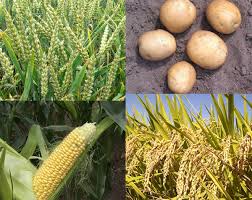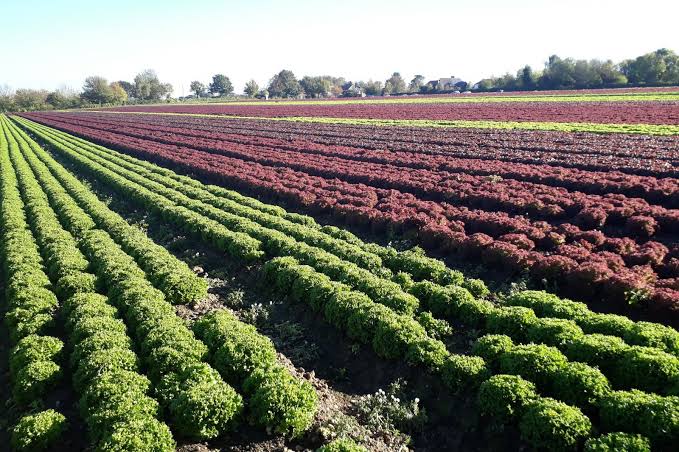Crop farming is the practice of cultivating plants for food, fiber, and other uses. It is a vital aspect of agriculture that plays a crucial role in providing sustenance for a growing global population. Farmers engage in crop farming to produce a diverse range of crops, including grains, vegetables, fruits, and oilseeds.
In the realm of crop farming, the selection of suitable crops depends on various factors such as climate, soil type, and local demand. Farmers often employ traditional methods passed down through generations, but modern techniques, such as precision farming and sustainable practices, are increasingly being embraced.
The foundation of successful crop farming lies in understanding the soil. Farmers assess soil composition, fertility, and drainage to determine which crops will thrive. Crop rotation is a common strategy to maintain soil health, prevent pests and diseases, and optimize yields.
Weather patterns significantly impact crop farming. Adequate water supply is essential, and many farmers rely on irrigation systems to supplement natural rainfall. In regions prone to drought, water management becomes a critical aspect of crop cultivation.
The choice between conventional and organic farming is another consideration for crop farmers. Conventional farming often involves the use of synthetic fertilizers and pesticides, while organic farming relies on natural methods to enhance soil fertility and control pests. Both approaches have their advantages and challenges, and farmers make decisions based on factors such as market demand and environmental impact.
Crop farming is not without its challenges. Pests, diseases, and unpredictable weather events can jeopardize yields. Farmers employ various pest control measures, from chemical pesticides to biological controls, to safeguard their crops. Additionally, advancements in biotechnology have led to the development of genetically modified crops, which offer resistance to specific pests or environmental conditions.
Harvesting marks the culmination of the crop farming cycle. Timing is crucial to ensure optimal crop quality and yield. Farmers use a variety of tools and machinery, from traditional hand tools to modern combine harvesters, depending on the scale of their operations.
Post-harvest activities include storage, processing, and transportation. Proper storage facilities help prevent spoilage, while processing adds value to the harvested crops. Transportation logistics play a key role in delivering fresh produce to markets, ensuring that consumers have access to a diverse and nutritious range of food.
Market trends and consumer preferences influence crop choices for many farmers. They adapt to changing demands by diversifying their crops or exploring niche markets. Sustainable farming practices are gaining prominence as consumers increasingly prioritize environmentally friendly and ethically produced food.
In addition, crop farming is a multifaceted endeavor that sustains communities, economies, and the global population. It encompasses a wide range of crops, methods, and challenges, requiring farmers to continually adapt to a dynamic agricultural landscape. As we navigate the complexities of modern agriculture, the importance of sustainable practices and responsible stewardship of the land becomes ever more apparent.
Read Also: Are Honey Bees Endangered?
Types of Crop Farming

Crop farming encompasses various types, each specializing in different crops or practices. Here are some notable types of crop farming:
1. Grain Farming: Focuses on the cultivation of cereal crops such as wheat, rice, corn, and barley. These crops are staple foods globally and serve as primary sources of carbohydrates.
2. Vegetable Farming: Involves the cultivation of a wide variety of vegetables, including leafy greens, root vegetables, and legumes. Vegetable farming is often characterized by diverse crops and shorter growth cycles.
3. Fruit Orchards: Specializes in growing fruit-bearing trees and plants, such as apple orchards, citrus groves, and vineyards. Fruit farming is crucial for providing essential vitamins and minerals in diets.
4. Oilseed Farming: Focuses on crops like soybeans, sunflowers, and canola, primarily grown for their oil content. These oils are used for cooking, industrial purposes, and in the production of various products.
5. Cash Crop Farming: Involves cultivating crops primarily for sale rather than personal consumption. Cash crops often include cotton, tobacco, and sugarcane, contributing significantly to the agricultural economy.
6. Mixed Farming: Integrates various types of crops and livestock within a single farming operation. This approach aims to enhance overall farm productivity and sustainability.
7. Specialty Crop Farming: Involves the cultivation of high-value, niche crops such as herbs, spices, and exotic fruits. Specialty crop farming often caters to specific markets and consumer preferences.
8. Organic Farming: Relies on natural methods without the use of synthetic fertilizers or pesticides. Organic crop farming focuses on maintaining soil health and biodiversity while meeting stringent organic certification standards.
9. Precision Farming: Utilizes technology, data, and advanced machinery to optimize crop yields while minimizing resource use. Precision farming involves precise monitoring and control of factors like irrigation, fertilization, and planting.
10. Subsistence Farming: A traditional method where farmers grow crops primarily for personal consumption. Subsistence farming is common in rural areas and plays a crucial role in food security for local communities.
11. Horticulture: Encompasses the cultivation of fruits, vegetables, nuts, seeds, herbs, sprouts, mushrooms, algae, seaweeds, non-food crops such as grass and ornamental trees and plants.
These types of crop farming demonstrate the diversity and adaptability of agricultural practices worldwide. Farmers often choose the type of farming based on factors such as climate, soil conditions, market demand, and personal preferences. Each type contributes to the global food supply chain, supporting both local communities and the broader economy.
Read Also: Facts About Honey Bees
How to Start Crop Farming

Starting a crop farming venture involves several essential steps. Here’s a general guide to help you embark on your crop farming journey:
1. Research and Planning: Conduct thorough research on the types of crops suitable for your region, considering factors like climate, soil type, and water availability. Create a detailed business plan outlining your goals, budget, crop selection, and marketing strategy.
2. Land Selection and Preparation: Choose a suitable piece of land with the right soil conditions and access to water. Conduct soil tests to understand its fertility and composition. Prepare the land by clearing debris, plowing, and leveling. Ensure proper drainage to prevent waterlogging.
3. Crop Selection: Based on your research and market demand, choose the crops you want to cultivate. Consider factors like crop rotation and diversification to enhance sustainability.
4. Seed Selection and Purchase: Select high-quality seeds from reputable suppliers. Consider factors such as seed variety, germination rates, and resistance to pests and diseases.
5. Planting: Follow recommended planting practices for each crop, considering factors like spacing, depth, and planting time. Be mindful of local climate conditions and seasonal variations.
6. Irrigation: Ensure proper irrigation to meet the water needs of your crops. Depending on your resources, you can use methods such as drip irrigation, sprinklers, or traditional watering.
7. Fertilization: Develop a fertilization plan based on soil nutrient levels and crop requirements. Use organic or synthetic fertilizers as needed, ensuring balanced nutrition for optimal crop growth.
8. Pest and Disease Management: Implement pest control measures, which may include the use of pesticides, biological controls, or integrated pest management (IPM) practices. Regularly monitor crops for signs of diseases or infestations.
9. Weed Control: Employ effective weed control methods to prevent competition for nutrients and sunlight. This may involve mechanical methods, mulching, or the use of herbicides.
10. Harvesting: Time your harvest based on the maturity of the crops. Use appropriate harvesting techniques and equipment to minimize damage to the plants.
11. Post-Harvest Handling: Handle harvested crops carefully to maintain quality. Consider post-harvest practices such as sorting, cleaning, and proper storage to prevent spoilage.
12. Marketing and Sales: Develop a marketing strategy to sell your crops. Explore local markets, supermarkets, or consider setting up a farm stand. Utilize online platforms and community engagement to promote your products.
13. Continuous Learning: Stay informed about advancements in crop farming techniques, technology, and market trends. Attend workshops, conferences, and network with other farmers to enhance your knowledge.
Remember that starting a crop farming venture requires dedication, hard work, and a willingness to adapt to changing circumstances. It’s advisable to seek guidance from experienced farmers or agricultural extension services in your area to enhance your chances of success.
Economic Benefits of Crop Farming
Crop farming contributes significantly to the economy in various ways, providing numerous economic benefits. Here are key aspects of the economic benefits associated with crop farming:
1. Employment Opportunities: Crop farming creates employment opportunities at various stages of the agricultural cycle, including planting, harvesting, processing, and marketing. This helps reduce unemployment rates and supports rural livelihoods.
2. Income Generation: Successful crop farming allows farmers to generate income through the sale of their crops. This income supports their families, contributes to the local economy, and provides financial stability.
3. Contribution to GDP: Crop farming is a substantial contributor to the Gross Domestic Product (GDP) of many countries. The value of crops produced and sold adds to the overall economic output, positively impacting the nation’s economy.
4. Export Revenue: Countries with successful crop farming operations often export surplus produce, generating foreign exchange earnings. Exporting crops contributes to a positive trade balance and enhances the economic standing of a nation.
5. Rural Development: Crop farming is a cornerstone of rural development. It helps build infrastructure, such as roads and irrigation systems, improving overall living standards in rural areas. This, in turn, reduces rural-to-urban migration.
6. Multiplier Effect: The economic impact of crop farming extends beyond the agricultural sector. Money earned by farmers circulates through the economy, benefiting related industries such as transportation, processing, and retail.
7. Supporting Agribusinesses: Crop farming creates demand for various agribusinesses, including seed suppliers, equipment manufacturers, and fertilizer producers. This creates a network of interdependent industries, fostering economic growth.
8. Food Security: Successful crop farming contributes to food security by ensuring a stable and diverse food supply. This stability reduces the reliance on food imports, stabilizing prices and reducing the vulnerability of the nation’s food system.
9. Technological Advancements: Investment in crop farming often drives technological advancements in agriculture. Innovations such as precision farming, genetically modified crops, and sustainable practices improve efficiency and productivity, contributing to economic growth.
10. Research and Development: Crop farming supports research and development activities aimed at improving crop varieties, pest resistance, and farming techniques. This investment in agricultural innovation benefits not only farmers but the broader economy.
11. Insurance for Farmers: Some countries have agricultural insurance programs that provide financial protection for farmers in case of crop failures due to adverse weather, pests, or diseases. This helps farmers manage risks and stabilizes their income.
12. Tourism and Agritourism: Successful crop farming can attract tourists interested in agritourism, creating additional revenue streams for farmers and local communities. Visitors may participate in farm activities or purchase farm products directly.
In summary, the economic benefits of crop farming extend beyond the agricultural sector, influencing employment, income, trade, and technological advancements. A thriving crop farming industry contributes significantly to the overall economic well-being of a region or country.
Read Also: A Guide to Waste Management Case Studies
